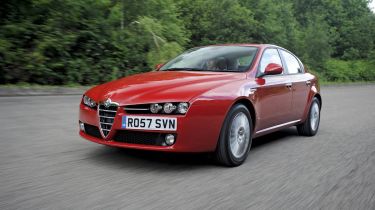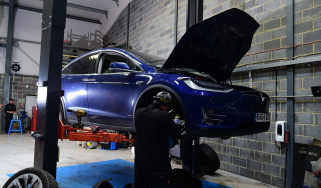Alfa Romeo 159 Lusso
Class benchmark for design remains a tempting proposition
Of all the cars in this class, the Alfa Romeo 159 makes one of the biggest statements. You know that whoever sits behind the wheel of a model like this has embraced the four-door and the quirks that go with it.
The car looks stunning. Every line oozes style, from the neat row of three round lamps either side of the grille to the triangular cut-outs beneath the chrome door handles. Despite being more than two years old, the 159 still managed to turn more heads than the new VW.
Only when you climb inside does the Alfa begin to show its age. It measures 4,660mm long and 1,830mm wide, so is 139mm shorter and 27mm narrower than the CC – and the tighter dimensions make it feel much more cramped inside.
An old-fashioned dashboard dominates the front, while occupants in the rear have little more space than they could expect in a compact family hatchback. At least tall passengers can sit upright, as there’s more headroom than in the VW.
While the Passat CC is unmistakably German inside, Alfa Romeo emphasises its country of origin by choosing not to translate many of the labels inside the 159’s cabin into English. Far from showing a lack of attention to detail, this adds to the sense that the four-door is born of a nation that’s passionate about cars. Everything from the ribbed leather seats to the small circular dials on the dashboard give the interior an atmosphere that the Passat CC can’t match.
But with character comes quirkiness. Living with the 159 day-to-day could get frustrating; the high seating position and awkward, overpriced £1,350 sat-nav are just two of the gripes which make the Passat seem like a more attractive alternative. The Alfa also forces you to compromise on boot space. The car’s smaller dimensions lead to a much tighter luggage capacity – you get 405 litres with the seats in place compared to 532 litres in the Volkswagen.
On the road, the Italian company has succeeded in making the 159 feel smaller than it is. The steering is reasonably weighted and the body responds well to changes in direction. While it’s less relaxing to drive than the VW, this frantic nature gives the impression the Alfa is more involving.
But the 2.2-litre engine is less responsive than the VW’s, and the 159 proved slower on the test track. Push to the limit, and the Italian is no more capable than its rival.
The biggest drawback of the Alfa’s less laid back approach is the ride quality. It’s just too harsh – if you have a long journey to tackle, the Passat CC would be the more comfortable option every time.
In 2.2-litre form, the 159 is competitive. Our Lusso costs £22,755. The question is whether its style outweighs its other flaws.
Details
Price: £22,755
Model tested: Alfa Romeo 159 Lusso
Chart position: 2
WHY: The 159 is one of the best-looking saloons on sale. We see if it has substance to match.
Economy
Wind the clock back three years, and Alfa Romeo dealers had a woeful reputation. But the manufacturer has taken drastic action to improve its franchises. A radical overhaul has improved its showing in our Driver Power dealer polls – and placed Alfa service standards above VW’s. Check-ups are cheaper, too, although in all other respects the 159 will cost more to run. With economy averaging a poor 23.2mpg and petrol prices rising, any 20,000-mile driver will pay over £4,500 annually for fuel. High emissions are also bad news for fleet users, with the Alfa costing a higher-rate taxpayer £2,822 a year – £802 more than the VW.







